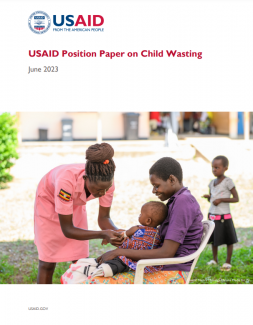USAID Position Paper on Child Wasting
June 2023
POSITION PAPER
The U. S. Agency for International Development (USAID) Multi-Sectoral Nutrition Strategy 2014–2025 seeks to improve nutrition to save lives, build resilience, increase economic productivity, and advance global development. The Strategy’s multi-sectoral approach addresses both direct and underlying causes of malnutrition and links humanitarian assistance with development programming to help build resilience to shocks in communities vulnerable to malnutrition. USAID’s approach to child wasting is guided by this Strategy, which prioritizes optimal nutrition outcomes for women and children in low- and middle-income countries.
In support of the renewed global attention to child wasting in recent years, including the development of the Global Action Plan on Child Wasting, USAID and the U.S. government have demonstrated their commitment to addressing child wasting globally:
During the 2021 Nutrition for Growth Summit, USAID’s Administrator Samantha Power announced that the United States intends to invest up to $11 billion over three years to combat global malnutrition. USAID also made a programmatic commitment to strengthen approaches to the prevention and management of wasting, particularly in non-emergency contexts.
The U.S. Government Global Nutrition Coordination Plan 2021-2026 (GNCP) has elevated the prevention and management of child wasting as one of its six priority areas. USAID and the Centers for Disease Control and Prevention co-chair an ad hoc working group on wasting under the Coordination Plan to facilitate information exchange in relation to wasting programming across the U.S. government.
The U.S. Government Global Food Security Strategy 2022-2026 includes a new focus on contributing to reducing child wasting and expands the Feed the Future research agenda to assess how our work contributes to wasting prevention.
In response to a growing need to effectively reach the unprecedented numbers of children experiencing acute malnutrition, in July 2022, USAID announced an additional $200 million award to UNICEF to scale up access to wasting treatment in the 13 countries most severely impacted by pandemic effects, climate shocks, and the food price crisis. These funds were provided in addition to supplemental funds allocated to both the World Food Programme (WFP) and UNICEF to meet increased caseloads in countries facing severe food insecurity. Ultimately, these funds were matched by an additional $370 million in resourcing from a broad range of funders before and during the UN General Assembly event: “The Child Malnutrition Crisis: Pledging to Save Lives” co-hosted by USAID and UNICEF.
In 2021, USAID established an internal Wasting Technical Working Group across three USAID Bureaus to identify opportunities at global and country levels to support wasting programming more strategically with an aim to scale up USAID support, particularly in non-emergency settings where wasting has received less attention.
In line with these commitments, the objective of this USAID Position Paper on Child Wasting is to summarize USAID’s approach to wasting programming and highlight areas for increased future investment.

